Another season of the NIFL Premiership is drawing to a close, and the top two teams are locked in a title race that could go right down to the wire.
Current holders Larne are sitting in first place and battling with 56-time champions Linfield, who are hot on their heels, just three points behind.
This is the penultimate game week and the top two face off against each other tonight in what could be the title decider.
A win for Larne would put them six points clear and see them retain their title, while a victory for Linfield would draw them level on points and send it right down to the wire.
This tactical analysis
will delve into the tactics of Larne FC andLinfield throughout the season to analyse what makes them the top two teams in Northern Ireland.
We will examine each team’s key tactical elements and pinpoint its strengths and weaknesses ahead of the NIFL Premiership title run-in.
Larne FC
We will begin this analysis by looking at Larne’s tactical setup under Tiernan Lynch.
The 44-year-old has been in charge at Inver Park since July 2017 and significantly impacted from the get-go as he guided Larne to promotion, winning the NIFL Championship in 2018/19.
Tiernan Lynch Formations
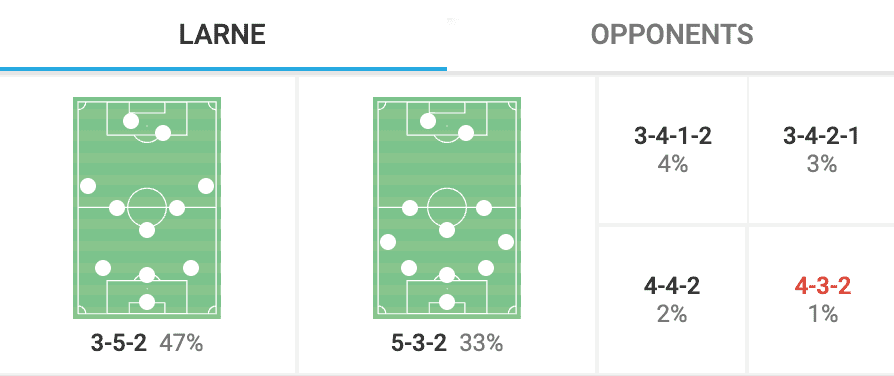
This graphic shows that Larne mostly plays a 3-5-2, which becomes a 5-3-2 in the defensive phase.
The three central defenders provide a solid foundation, offering numerical superiority against opposition attackers.
Furthermore, this system allows for effective pressing and counter-pressing, something that Larne looks to utilise in its style of play.
With the five players across the middle and two forwards capable of applying pressure on the ball carrier, Larne force turnovers in advanced areas of the pitch.
This aggressive, pressing approach can disrupt the opposition’s build-up play and means they can win back possession quickly.
Their tactical system gives them flexibility and unpredictability in attack, as multiple players can contribute to the attack from different positions on the pitch.
The two strikers provide a potent attacking partnership, with one striker often dropping deep to link up play and create space for the other to exploit.
Meanwhile, the wing-backs can provide support from wide areas, delivering crosses into the box or cutting inside to take shots on goal.
Larne averages 58.01% possession per 90, so they want to monopolise possession and build strategic attacks where possible.
Overloads and positional rotations

This heatmap shows where on the pitch Larne is most active.
It shows that Tiernan Lynch’s team prefers to play down the left side more than the right.
This could involve overloading the left and switching play out to the opposite side, where more space exists to exploit.
The increased presence of attacking players in a specific area often forces the opposition to shift their defensive focus accordingly, potentially leaving gaps elsewhere on the pitch.
This can lead to defensive errors as the opposition struggles to cope with the overload and effectively cover all attacking threats.
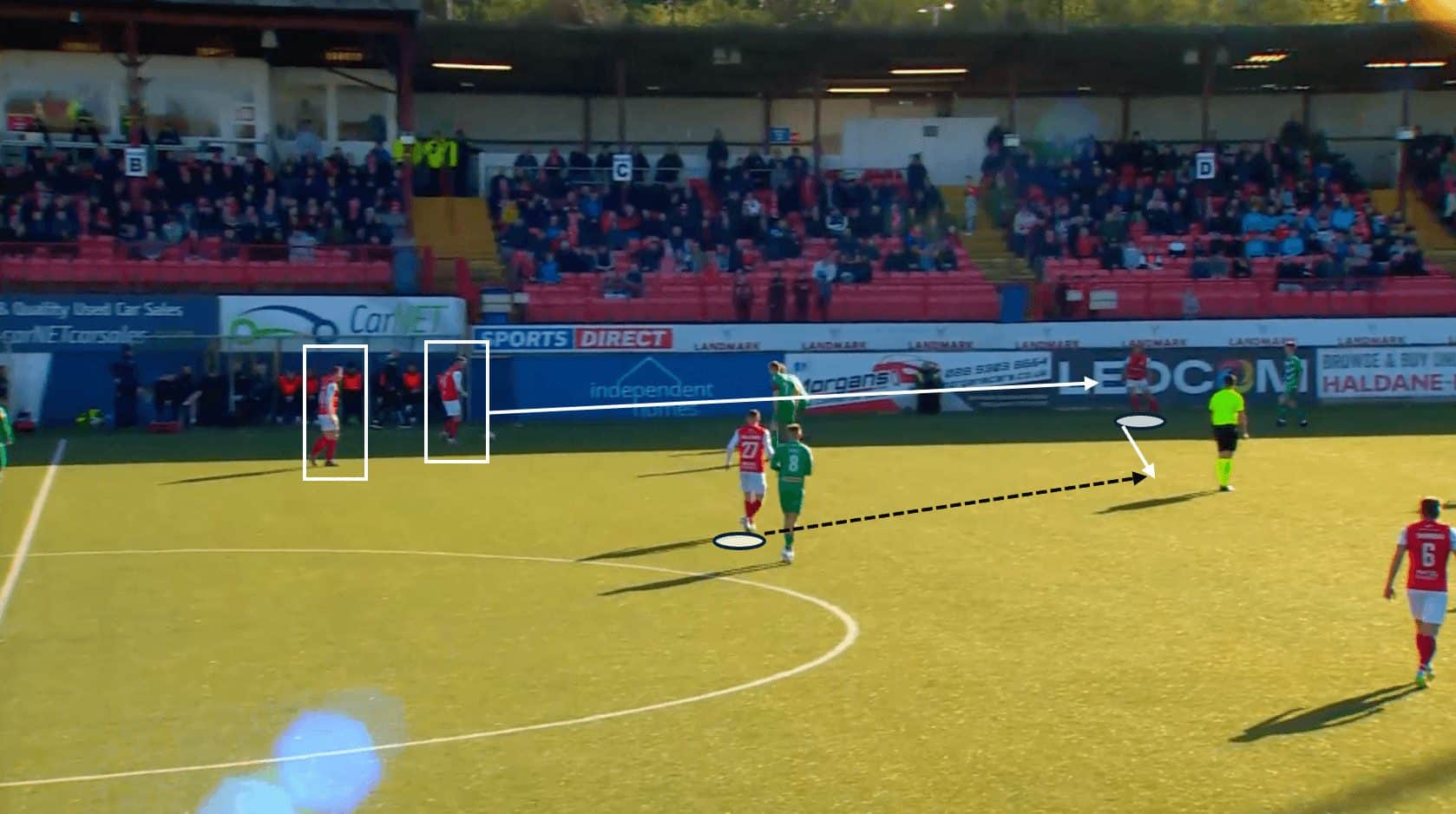
Larne will often look to focus their attacking play down the left side whenever possible.
Consequently, Levi Ives and Sam Graham, who have both been utilised at left wing-back this season, have racked up 11 and four assists, respectively.
In this example, we can see how they like to stretch the pitch by positioning players as wide as possible.
This attracts the opponents to move towards the Larne players, leading to spaces in more central areas that can be exploited.
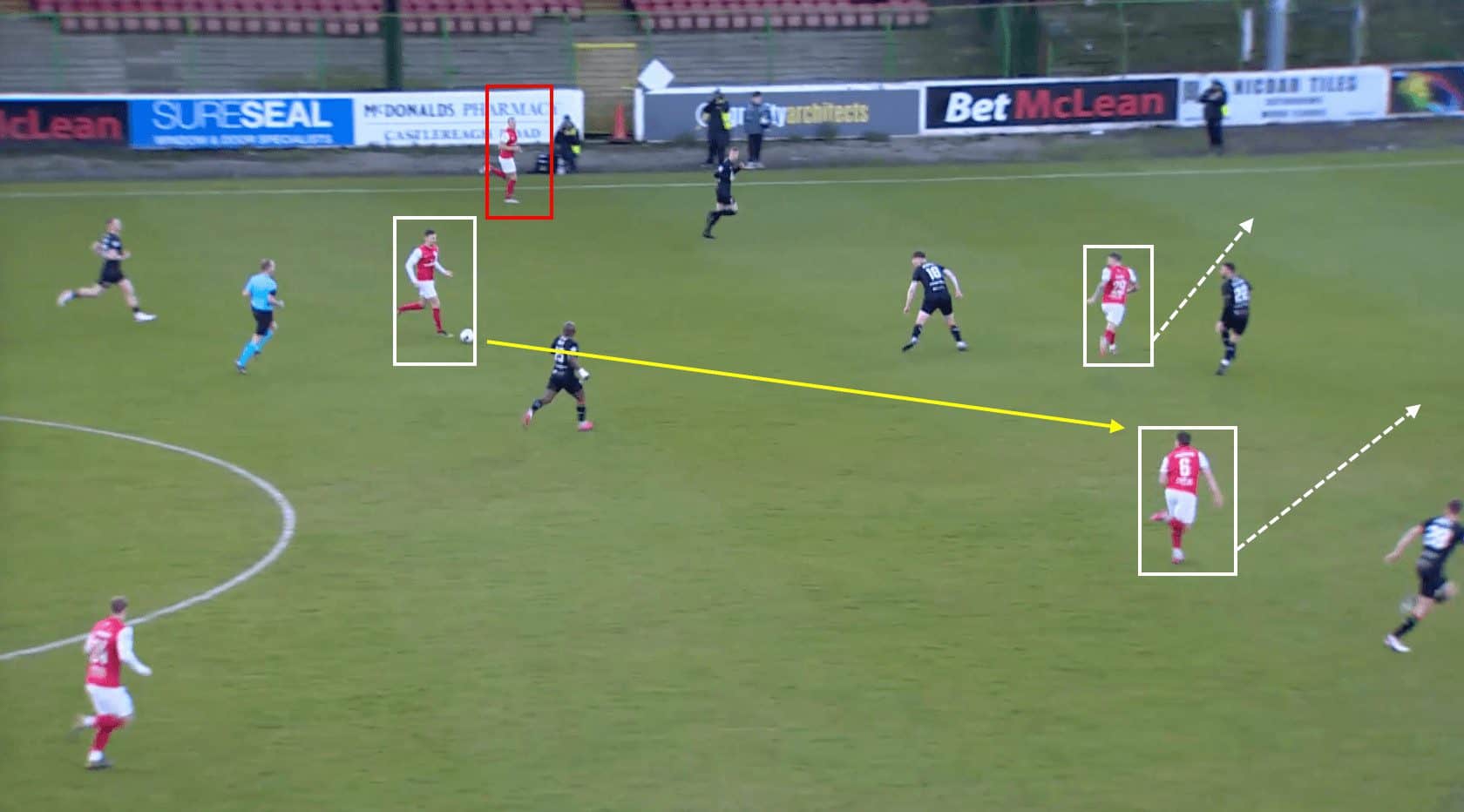
In this instance, the left wing-back stays as wide as possible, acting as a decoy to attract the opposition full-back.
With the full-back focused on Larne’s wing-back, Andrew Ryan (#29) makes a darting run into the left channel, which drags the opposition central defender with him.
Consequently, this creates a huge gap between the two central defenders, which Joe Thomson, Larne’s #6, is only too happy to occupy.
Ryan’s movement not only stretches the opposition’s defensive line but also disrupts their defensive structure, opening up the passing lane in the centre and providing Thomson with the opportunity to make his run in behind.
Moreover, as the midfielder makes a dynamic run into the open area, he can receive the pass and then drive forward with the ball to create scoring chances.
With fewer defenders to contend with centrally, Thomson has more time and space to orchestrate plays and unleash shots on goal.
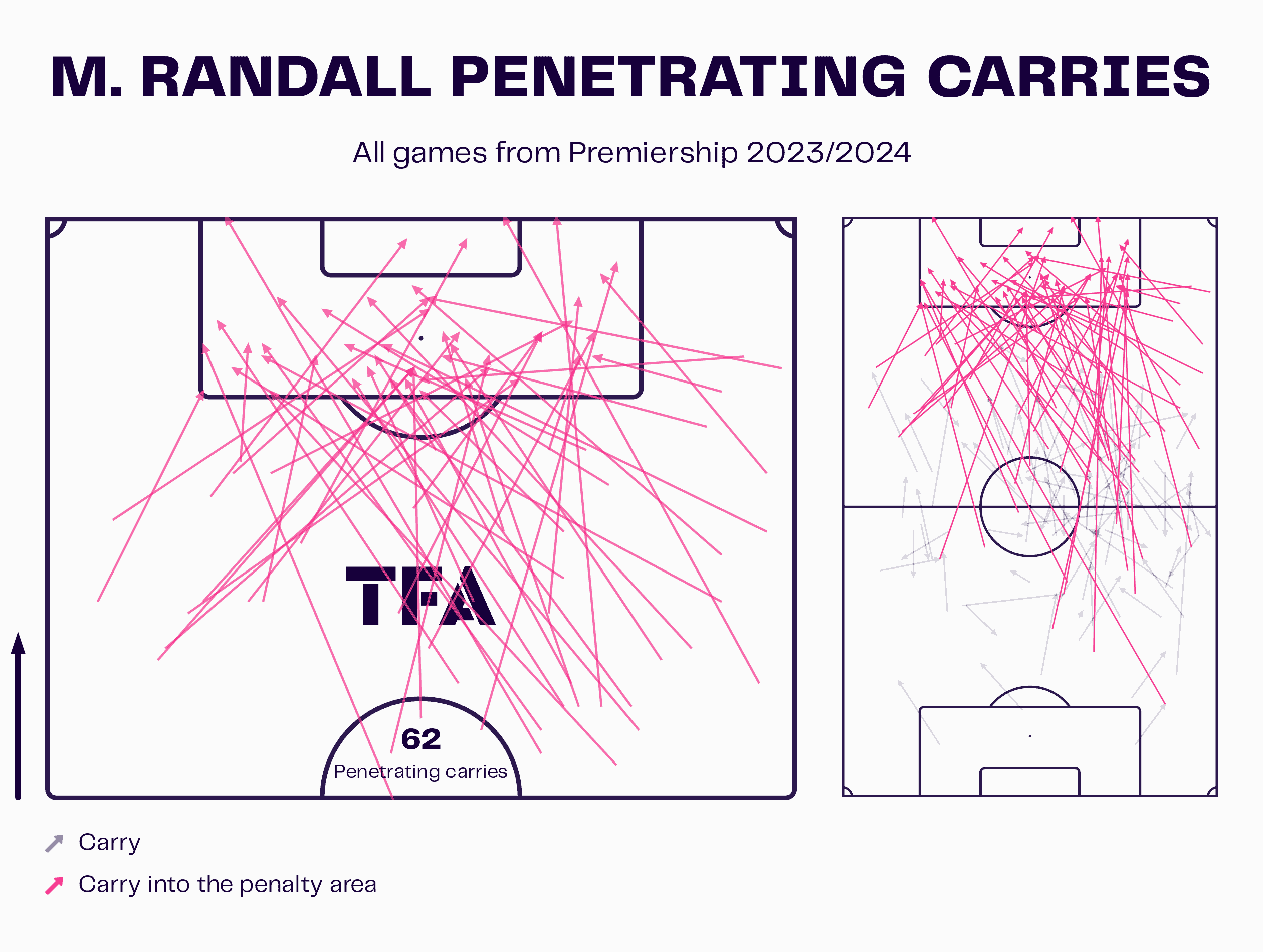
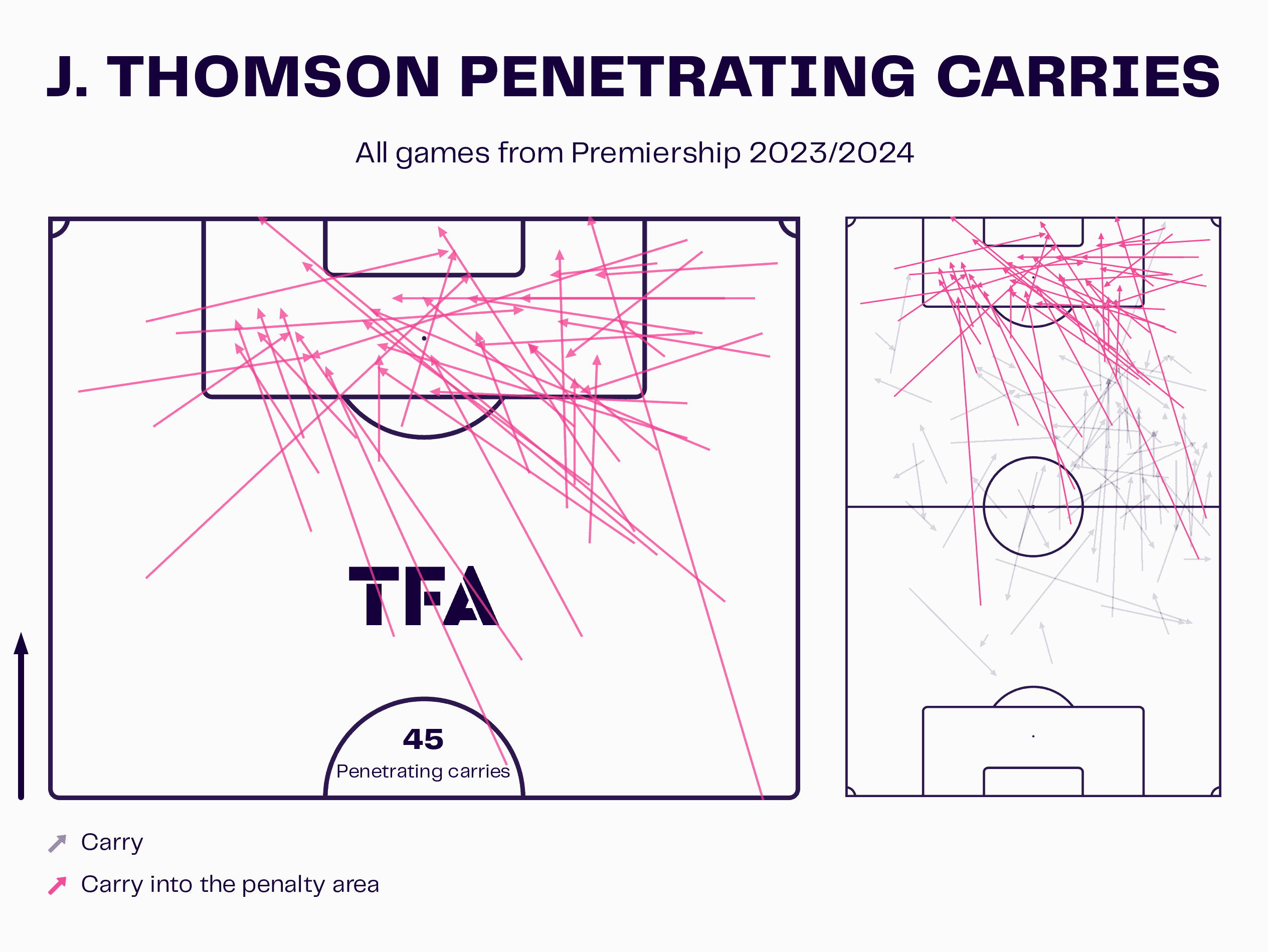
The data visuals above show us the penetrating carries from two of the players who have occupied Larne’s three midfield spots this season.
Thomson and Randall both look to carry the ball forward from more central areas, which allows Larne to execute Lynch’s tactics.
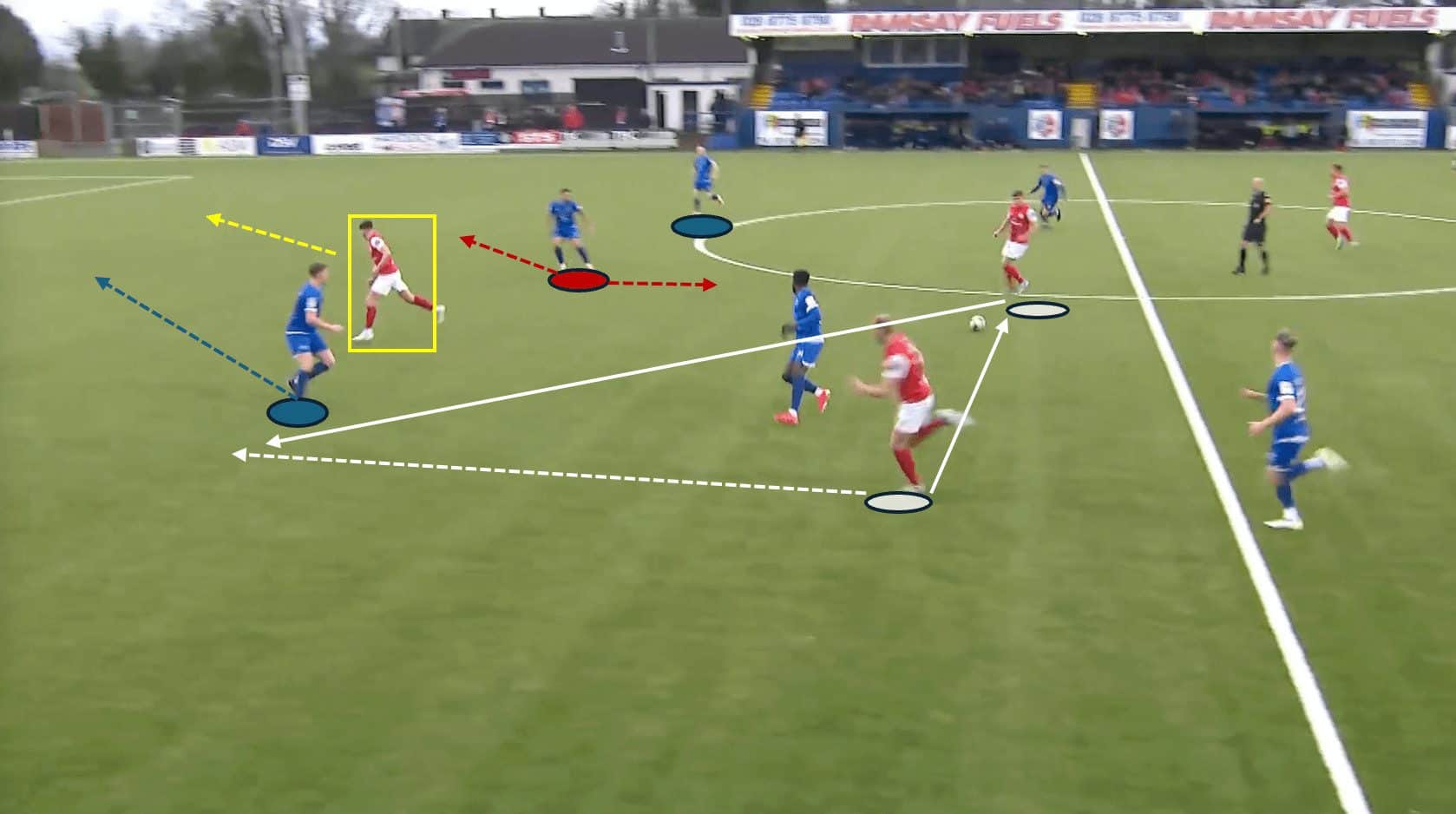
Furthermore, Larne seeks to pin back their opponent’s defensive line by always ensuring that one of their two strikers remains high up the pitch when the team are in the defensive phase.
We can see how high Lee Bonis is in this example.
His positioning causes problems for the opposition’s central defenders, who are unsure whether to track his movement or step out and press Larne as they look to build an attack.
Bonis occupies the central defenders and prevents them from pushing forward, creating gaps in the defence that teammates can exploit by making runs from deep or attacking midfield positions.
Additionally, this allows the forward to act as a focal point for the team’s attacking play.
He can hold up the ball and bring teammates into play by laying off passes to the onrushing midfielders and wing-backs.
As defenders are drawn towards the striker, gaps open up in the channels and on the flanks, allowing midfielders to create overloads and wide players to make overlapping runs to deliver crosses into the box.
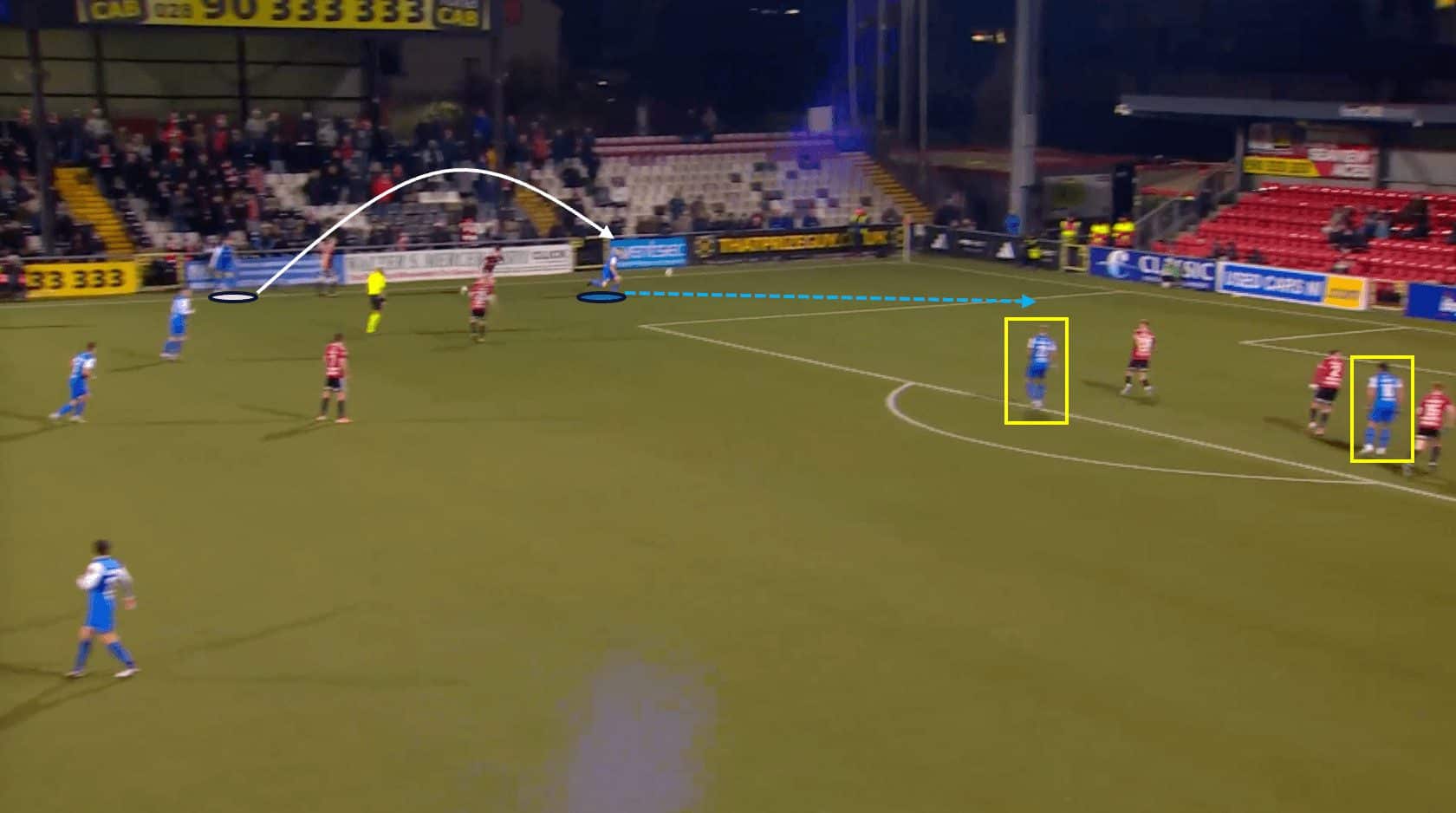
In this example, Andrew Ryan (white circle) has drifted out to the left flank to link up with Levi Ives (blue circle).
Therefore, midfielder Leroy Millar has joined Bonis in the opposition penalty area.
The swift link-up play between Ryan and Ives means the Crusaders’ pressure is completely bypassed, and the wing-back has plenty of space to drive into.
With Millar and Bonis occupying the defenders in the box, Ives can carry the ball all the way to the byline before executing a cut-back.
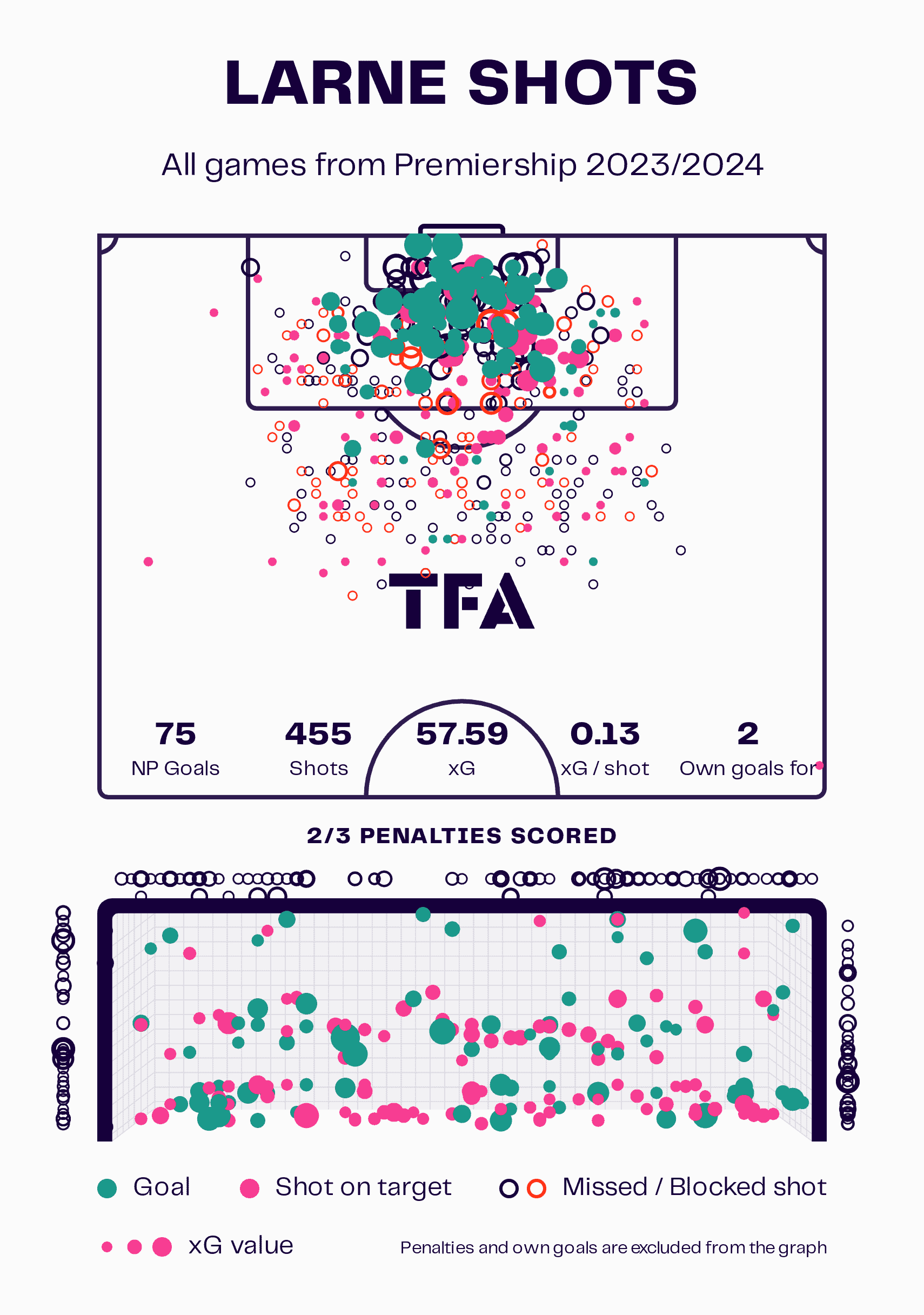
Larne’s attacking style of play certainly pays dividends.
The data visual above shows that they have netted 75 non-penalty goals from an xG of 57.59 so far this season.
The County Antrim-based team has recorded some pretty hefty scorelines, including the recent 8-1 demolition of Cliftonville, 6-1 at home against Glenovan, and 4-0 victory against Newry City.
Of course, whilst this does suggest that Larne are scoring lower percentage chances given the drastic xG overperformance, we must also consider that perhaps some of the opposition goalkeepers and defences may have underperformed in these games.
The two starting forwards, Lee Bonis and Andrew Ryan have been particularly lethal in front of goal, having netted 17 and 23 goals so far this season.
High pressing
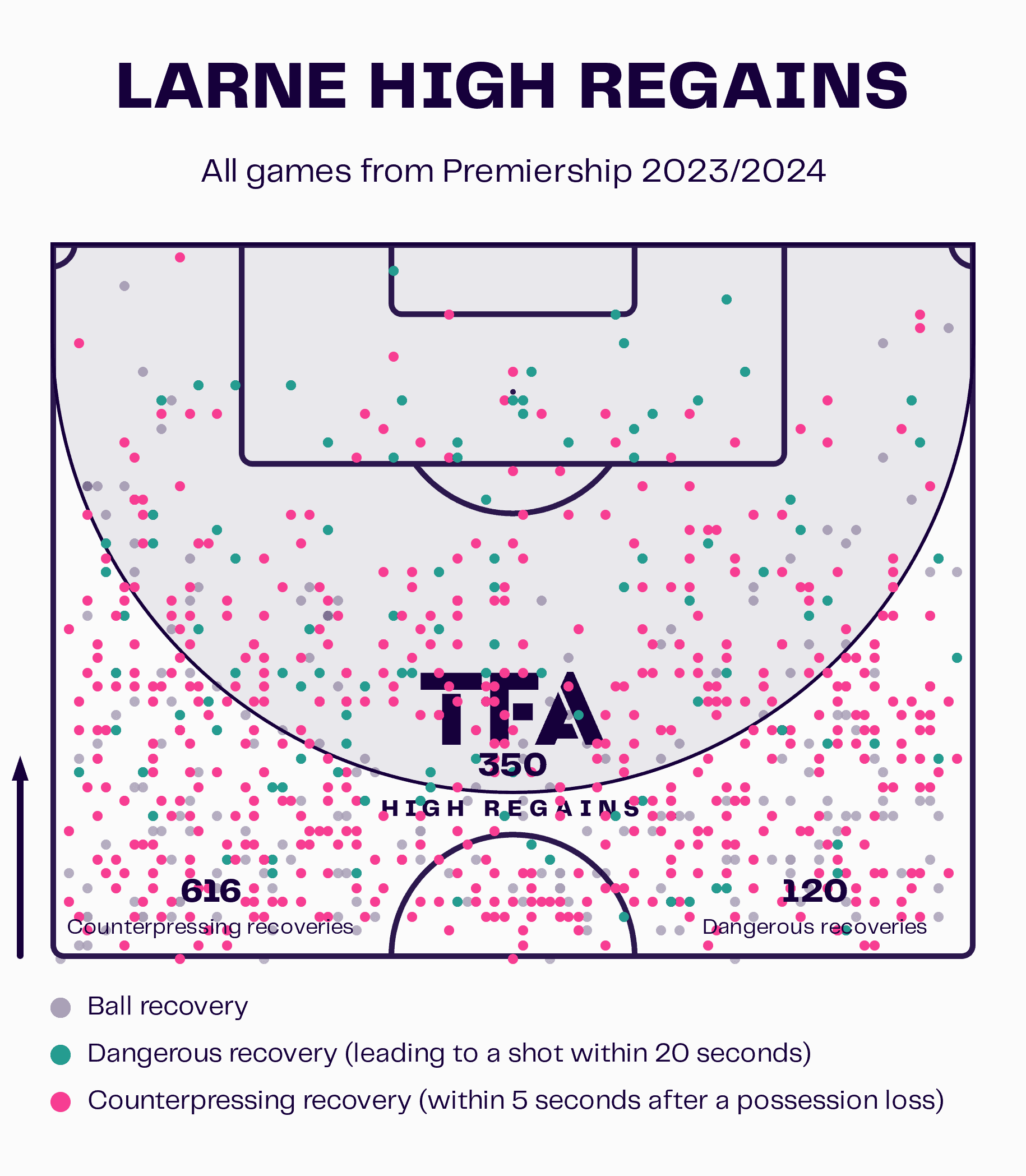
Larne’s defensive tactics revolve around counter-pressing and pressing high.
Tiernan Lynch’s men have an average PPDA of 8.17, so they typically allow their opponents roughly eight passes before initiating a defensive action.
The data visualisation shows that Larne has completed 350 high regains this season and 616 counter-pressing recoveries.
Plus, 120 of these recoveries have been classed as ‘dangerous,’ meaning that they led to a shot within 20 seconds of recovering possession.
Counterpressing immediately after losing possession allows Larne to quickly regain control and prevent the opposition from launching a dangerous counter-attack.
With the immediate pressure on the ball carrier, Larne can disrupt the opposition’s transition play and force turnovers.
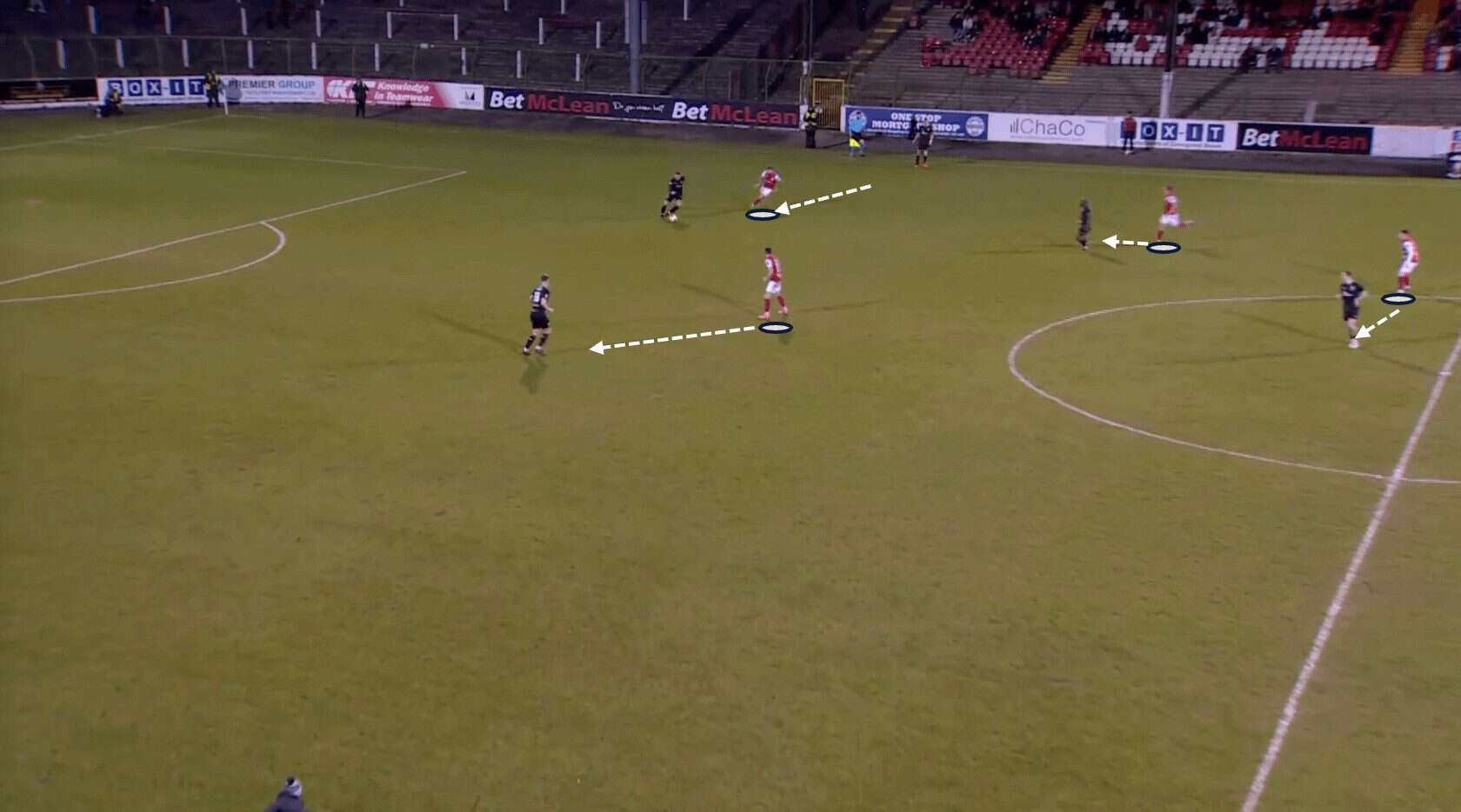
We can see the Larne press in effect here; they stick closely to their opponents and constantly put them under pressure.
This is what disrupts the opposition’s rhythm and prevents them from building sustained attacks.
On this occasion, the opposition tries to play through the middle, but the team in red quickly recovers the ball.
By closing down space and applying pressure on the ball carrier, the team denies the opposition time and space to settle and dictates the game’s tempo to orchestrate their attacking play.
This approach also instils a sense of urgency and panic in the opponent’s play, leading to mistakes and turnovers, on which Larne promptly capitalises.
Linfield
In this section of the analysis, we will examine Linfield’s style of play and see if there are any major similarities or differences with how Larne set up.
Current manager David Healy has been in post since 2015 and enjoyed great domestic success, having won the league on five occasions.
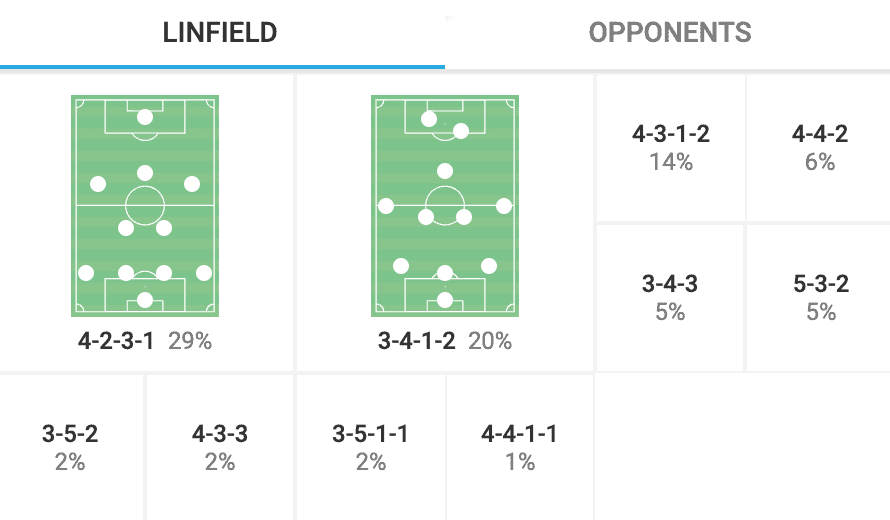
Healy, who began his footballing career on the books of Manchester United, has opted for a few different systems this season.
This graphic shows that the most used formation for Linfield has been the 4-2-3-1, closely followed by a 3-4-1-2 system.
The Blues average 54.37% possession per 90 minutes, so slightly less than Larne, but they certainly look to retain the ball and dominate where possible.
Both systems offer flexibility and adaptability, defensive solidity and attacking fluidity.
Additionally, there is the opportunity to create attacking overloads and ensure that the team is not overrun either centrally or out wide, ensuring a solid defensive structure.
Switches of play and overloading the box
Linfield’s build-up play revolves around moving the ball swiftly down one flank and then switching the play to the opposite flank.
A switch pass is a strategic manoeuvre where a player quickly changes the direction of play by delivering a long, diagonal pass from one side of the pitch to the other.
When executed with precision and pace, it usually bypasses congested areas in the centre of the field and exploits space on the opposite flank.
This is primarily used as a means of unlocking stubborn defences and breaking down compact structures.

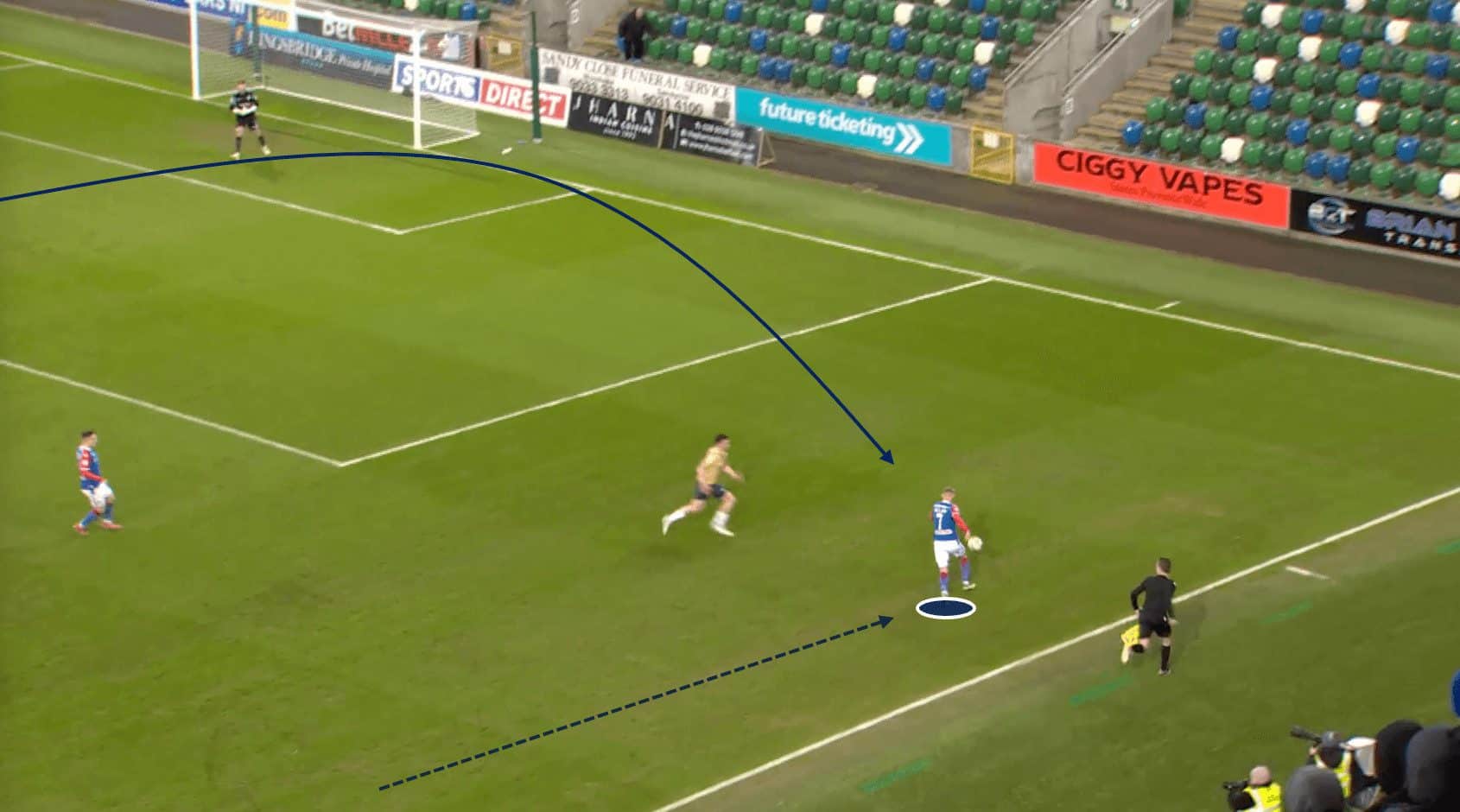
We can see here that Linfield starts working the ball down the left, which, of course, draws the opposition over to that side.
The Blues then bring the ball inside and pass it to the central defender, who looks to play a long pass out to the right.
Kirk Millar anticipates this and makes a well-timed run down the right flank. Due to the opposition being drawn to the opposite side, he has acres of space ahead.
Millar is then able to execute a first-time cross into the penalty area, looking for a teammate.
By rapidly transferring the ball from one flank to the other, Linfield aims to disorient the opposition’s defensive structure and create opportunities for their attacking players to receive the ball in space, with time to put crosses into the box, run at the defence, or create goalscoring opportunities.

On this occasion, Ben Hall executes a wonderful long pass out wide to his teammate, who then completely removes the opponent from the game via a first-time chest pass to Kyle McClean, who has plenty of space to exploit.
Linfield averages 55.3 long passes per 90 minutes with a 52% accuracy rating, demonstrating their commitment to playing this way.
This allows Healy’s side to control the game’s tempo, as they can use their long-passing prowess to facilitate rapid transitions from defence to attack.
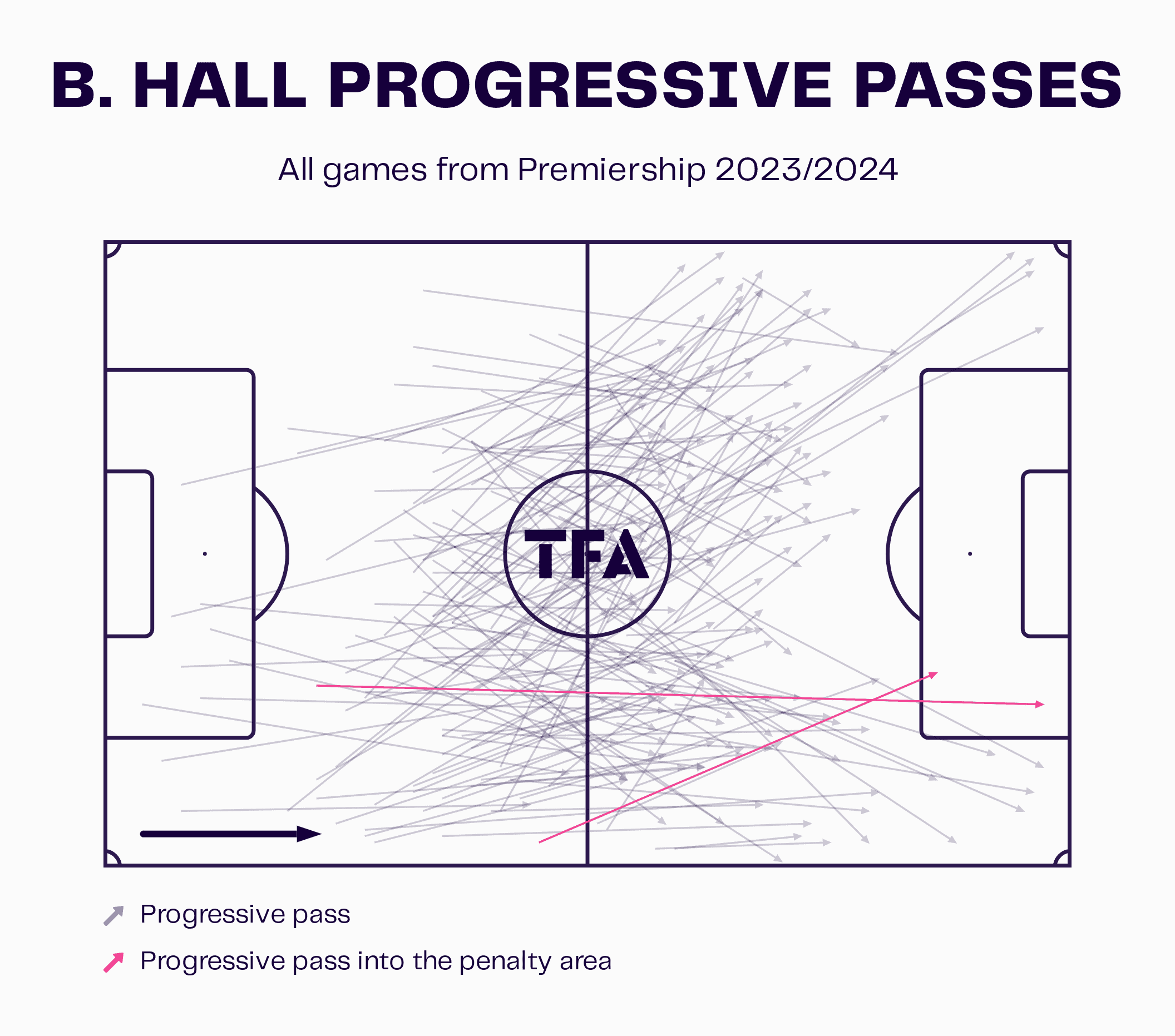
Furthermore, if we look specifically at Ben Hall’s progressive passes this season, we can see how instrumental the 27-year-old is at playing long progressive passes in wide areas.
The central defender, who was once on the books of Premier League side Brighton, averages 7.6 progressive passes per 90 and often plays a key role as Linfield begin to build an attack.
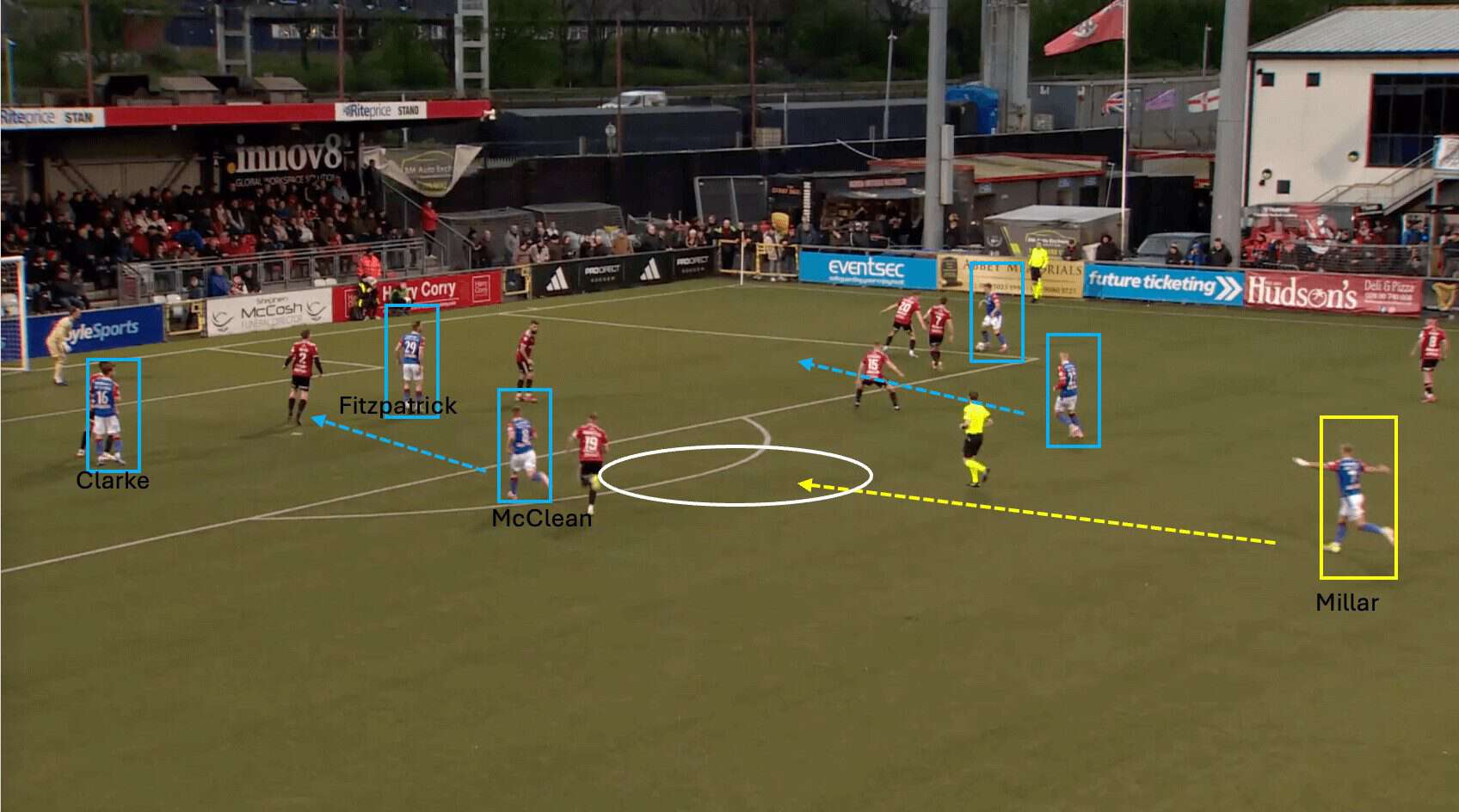
Additionally, The Blues consistently aim to ensure there are several bodies in the box for the players out wide to aim for.
In this instance, we can see that Clarke and Fitzpatrick are already in the opposition penalty area, anticipating a cross coming in from the right.
Moreover, Kyle McClean is making a run into the box, dragging the opposition midfielder with him.
This, as shown above, creates space for Kirk Millar, who is making a late run to the edge of the area.
Firstly, by sending multiple runners into the penalty area, the Linfield team automatically increase the number of targets for crosses and passes into the box.
This can confuse the opposition defence, as they are forced to track the movement of multiple attackers.
This increases the likelihood of defensive errors and provides more opportunities for attackers to intercept crosses and score goals.
As runners draw defenders away from the edge of the area, midfielders such as Millar can find pockets of space in and around zone 14 to receive the ball and potentially shoot from distance, play through balls, or link up with other attackers.
This creates opportunities for more dynamic and unpredictable attacking play from Linfield, as they have multiple players capable of contributing to goal-scoring opportunities.
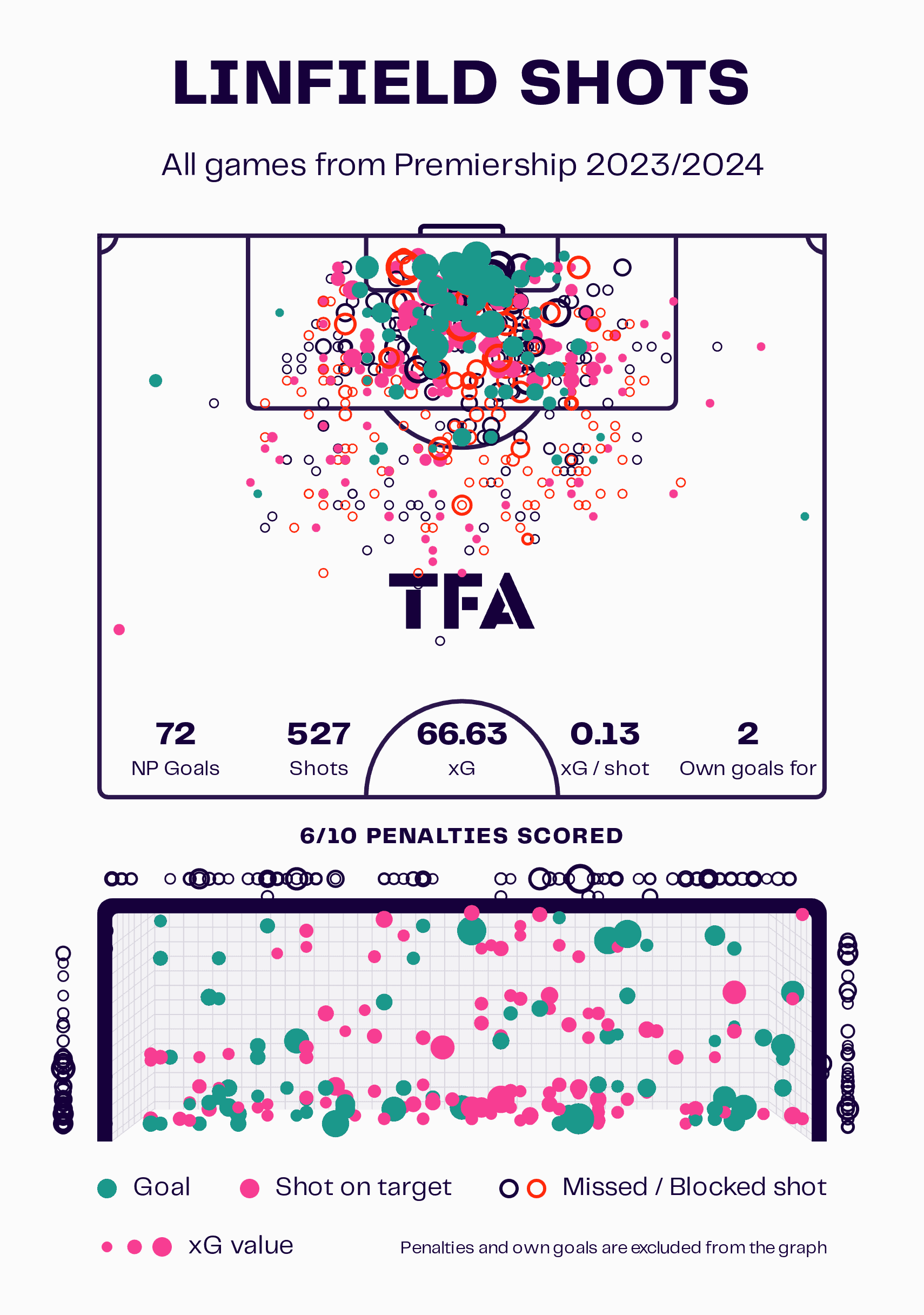
This data visual shows how effective Linfield’s attacking play is in terms of goal output.
With 72 non-penalty goals from an xG of 66.63, Linfield certainly knows how to find the back of the net, as we noted with Larne.
Again, the vast overperformance suggests the Blues can score the lower percentage opportunities.
It is also worth noting that Linfield have taken more shots than Larne this season, 527 compared to 455.
Perhaps the Blues are more willing to shoot from difficult angles, or their attacking play could create more shooting opportunities.
Defending from the front
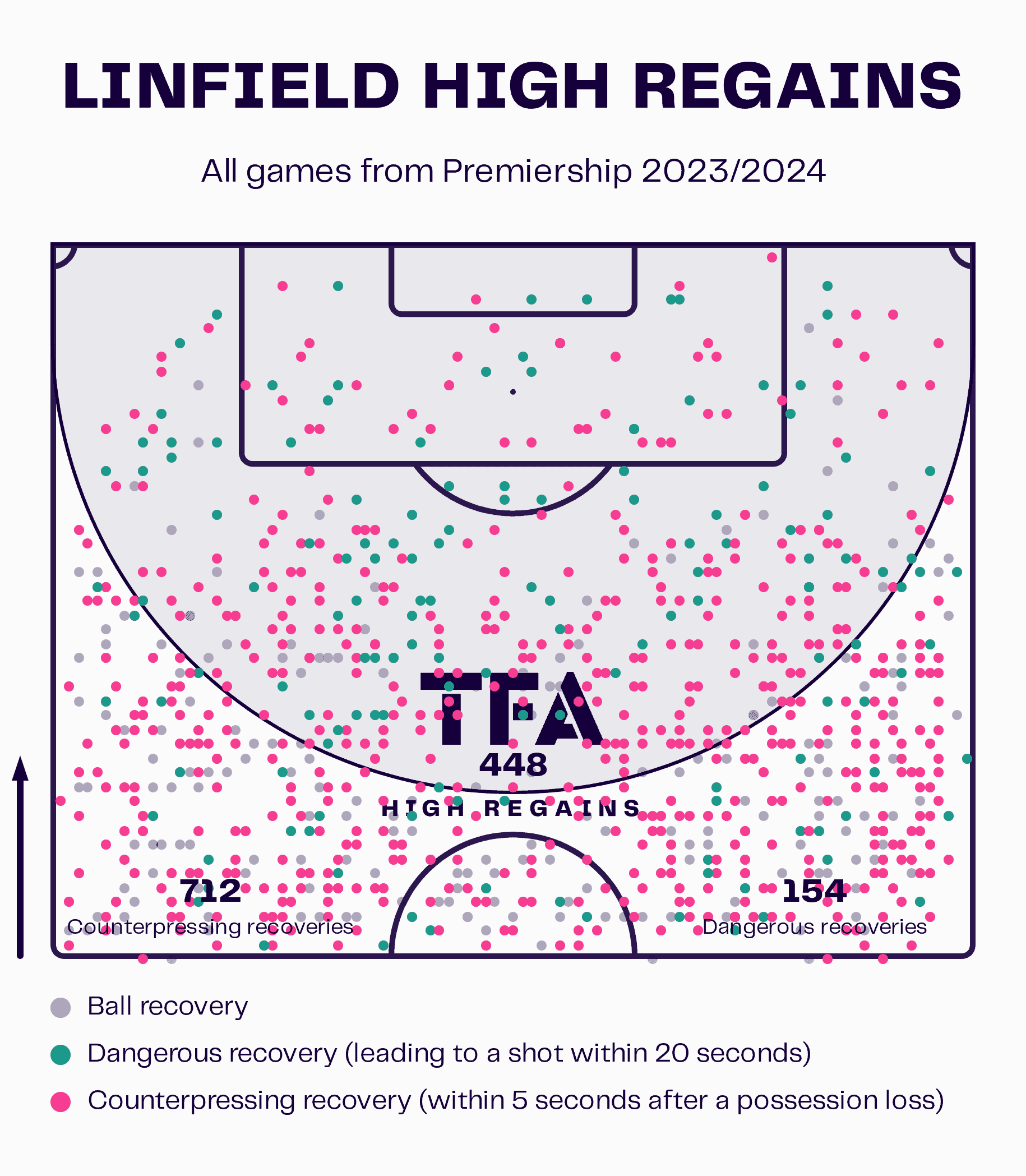
Defensively, Linfield adopt an aggressive high-pressing and counterpressing style, very similar to what we see with Larne.
We can see in this data visual that Linfield have made 448 high regains so far this season,
They have made 712 compressing recoveries, which shows how they aim to recover possession immediately after losing it.
Furthermore, 154 of these recoveries led to shots within 20 seconds.
This means Linfield are preventing the opposition from launching dangerous counter-attacks.
As they apply immediate pressure on the ball carrier and surround them with multiple players, it limits the opposition’s transition play and forces turnovers in areas where they are most vulnerable.
Plus, Healy’s side can sustain attacks and keep the opposition pinned back in their own half, limiting their ability to build sustained relief from the pressure.
This proactive approach prevents the opposition from gaining momentum and allows Linfield to dictate the flow of the game, maintaining their dominance throughout.
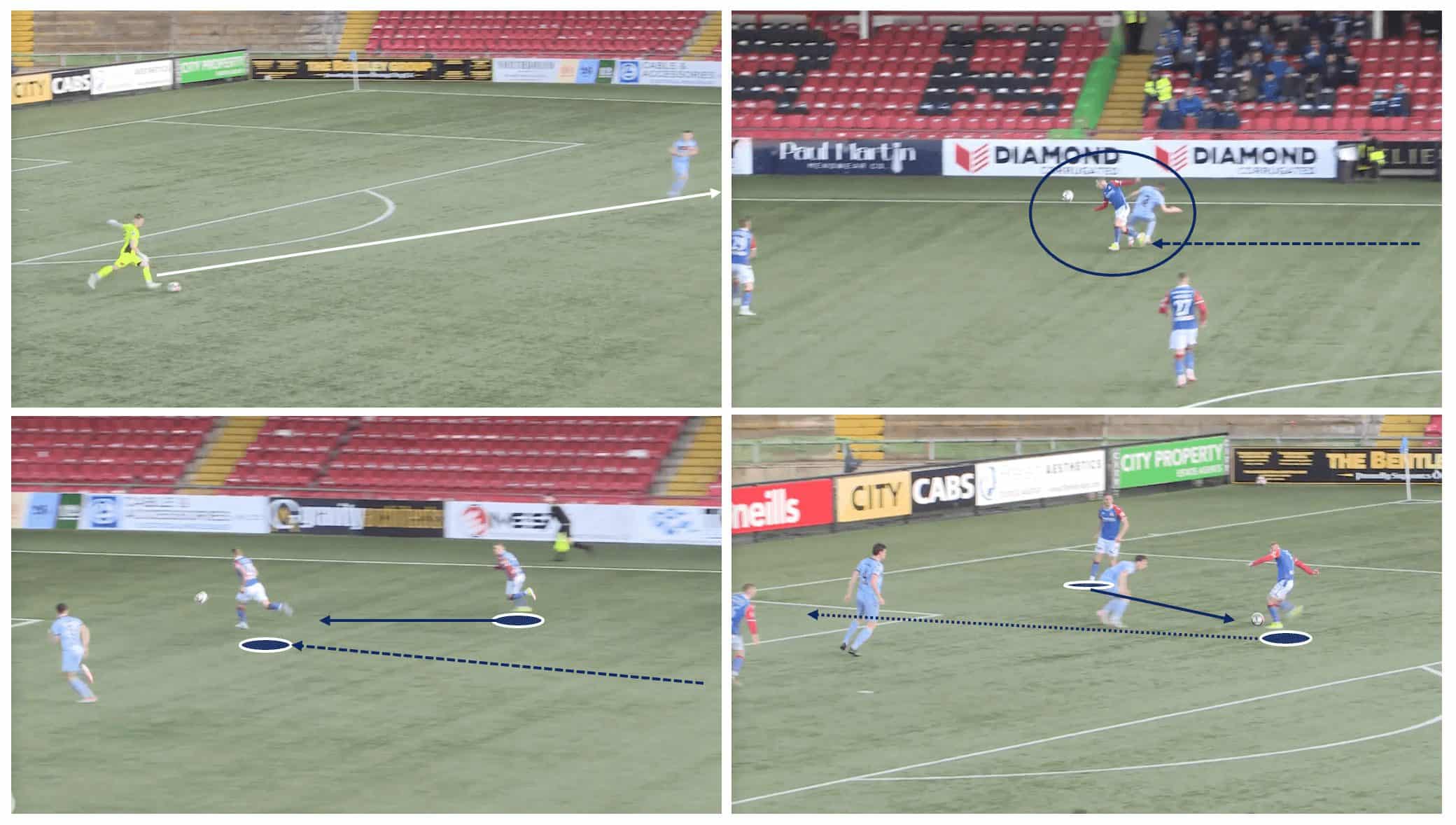
As we can see here, Linfield also looks to prevent their opponents from playing out of defence.
The opponents are trying to build out with the goalkeeper playing the ball out to the full-back.
Linfield springs into action immediately and puts the opposition full-back under pressure before he can bring the ball under control.
The Blues recover possession and rush forward to ensure players are available in attack.
Some swift link-up play between Fitzpatrick and Millar down the right results in the latter taking a shot at goal within five seconds of recovering possession.
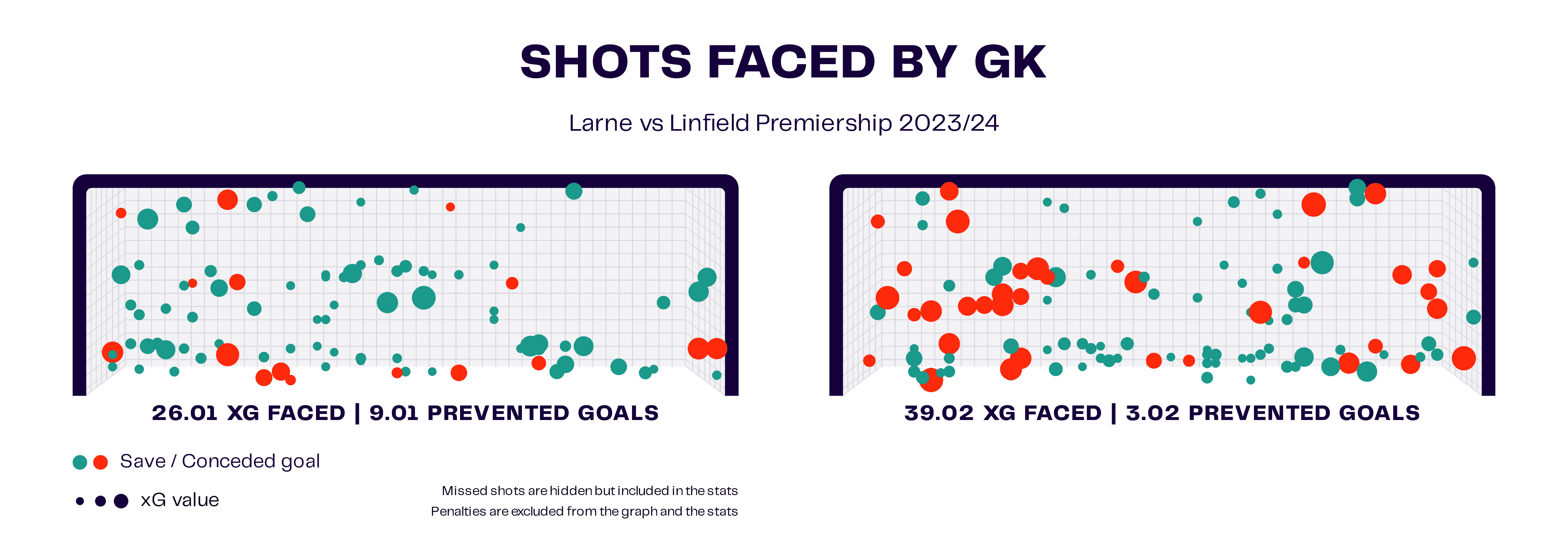
Finally, this data visual shows us the shots faced by both Larne and Linfield throughout the season.
We can see that Larne have faced an xG of 26.01 compared to Linfield’s 39.02.
From this, we can infer that it is more difficult for opponents to break down Larne’s defence, which will most likely play a massive role in the upcoming face-off between the two sides.
Furthermore, Larne’s goalkeeper, Rohan Ferguson, has prevented 9.01 goals this season, demonstrating his importance to this team.
Conclusion
This scout report investigates Tiernan Lynch’s and David Healy’s tactics as the NIFL Premiership draws to a close.
Larne and Linfield are both very attack-minded teams who like to press high up the pitch to sustain their attacks and prevent the opposition from being able to play out.
It will be interesting to see which team comes out on top of tonight’s battle.
Larne went into the tie three points ahead and was in good form, but Linfield and David Healy will undoubtedly be out to cause an upset.
Whatever happens, both teams have treated fans to some exhilarating football this season in the battle for that coveted UEFA Champions League qualifying spot.





Comments